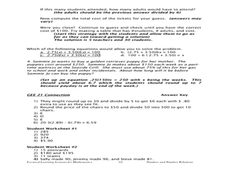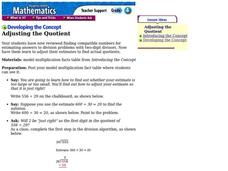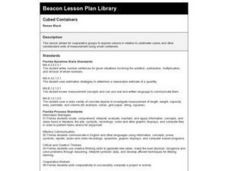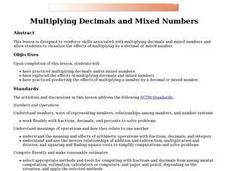Curated OER
Operations for Problem-Solving
Students examine a problem and develop the best method to arrive at the solution. In this math lesson, students apply basic math skills by coming up with the correct steps to solve a word problem. ...
Curated OER
Adjusting the Quotient
Students solve division problems. In this division lesson, students review estimating and how to figure out if their estimate is too large or too small. Students solve division problems and use their estimating skills to adjust the...
Curated OER
Measuring and Predicting Capacity
Students investigate geometric shapes through volume and dimensions. In this geometry instructional activity, students measure, weigh, and calculate sizes and volume based on estimation and calculation. They review important vocabulary...
Curated OER
Using Inequalities to Problem Solve
Students explore inequalities. In this Algebra I lesson, students solve and graph linear inequalities involving addition, subtraction, multiplication, or division. Students use inequalities to solve and graph real-world problems.
Curated OER
School Store
Fourth graders complete a worksheet where they calculate costs of items in a school store by using multiplication. In this multiplication lesson plan, 4th graders find the total cost of all the supplies and the cost per item.
Curated OER
Buying a Car
Pupils complete the PLATO ¿¿ Educational Software lesson: Math Problem Solving: Car Costs to determine if he/she can afford to drive the car they are planning to buy.
Helping with Math
#10: Solving Equations (2 of 2)
In this prealgebra activity, pupils perform addition, subtraction, multiplication, or division operations to solve for an unknown. There are 12 problems to be solved. Use this as a quiz to assess how well your class is grasping the skill...
Curated OER
What are the Odds
Learners predict the-outcome of an event. In this algebra lesson, students compare and contrast the probability of an event occurring. They calculate the odds of a simple event and make estimation.
Pennsylvania Department of Education
Using the Coordinate Plane in Problem Solving
Fifth graders practice solving problems. In this fraction and decimal lesson, 5th graders recognize the relationship between fraction and decimals. Students estimate problem results and write expressions to use for problem...
Curated OER
Estimating Quotients
In this estimating quotients instructional activity, students solve 20 different problems that include estimating a variety of quotients in each. They divide each whole number and then estimate the answer in each problem to the nearest...
Curated OER
Daily Upkeep 6
In this multiplication worksheet, 4th graders complete a quick math sheet where they first solve a problem on how many walked. Then, they identify and solve how they would find a paired number set in a table. Finally, students identify...
Curated OER
Find the Missing Products
In this multiplication worksheet, students solve 40 problems in which two and three digit numbers are multiplied by single digits. Students are encouraged to use estimation to do mental math. This page is intended as an online activity,...
Curated OER
Estimating the Product to a Multiplication Problem
In this middle school mathematics worksheet, students round whole numbers to the nearest leading digit and then multiply to obtain an estimate of the product. The one page worksheet contains ten problems. Answers are not...
Curated OER
Cubed Containers
Learners explore volume in relation to centimeter cubes and other nonstandard units of measurement using small containers. They will use hands-on materials to practice this concept. You will need small objects and containers to set this up.
Curated OER
How Big Is It?
Fifth graders look at the Garrison flag and estimate how big it is. For this measurement lesson plan, 5th graders then calculate the area and perimeter of the flag.
Curated OER
Rounding And Estimating
Students investigate various types of problems using whole numbers and decimals. They use a discussion format while working example problems to help create a baseline for further independent practice. The activity also includes praise...
Curated OER
"Adding It Up" at James Fort
Students discuss jettons and their archaeological importance at Jamestown. They then practice using historic counting sheets and artifacts to understand the calculating methods of the early 17th Century, and identify their similarities...
Curated OER
Multiplying Decimals and Mixed Numbers
Students multiply decimals and/or mixed numbers. They explore the effects of multiplying decimals and mixed numbers. They practice estimating answers when a number is multiplied by a decimal or mixed number.
Curated OER
Skip it to multiply it
First graders make sensible estimates and check the reasonableness of answers.
They make up, tell and record number stories up to 9 about given objects. They skip count in twos, threes and fives.
Curated OER
Working Watermelon
You're going to wish you had a watermelon for this lesson! Class members read about watermelons and make a salad in class to sample. They also perform estimates, measurements and calculations on a watermelon. They predict what percentage...
Curated OER
Multiplying Decimals
In this mathematics worksheet, 6th graders estimate the product and use an array to help them find the product. Then they find the exact product and locate where to put the decimal point in each.
Curated OER
Pascal's Triangle
Students explore the concept of Pascal's Triangle. In this Pascal's Triangle lesson, students use an applet called 'Coloring Multiples' to explore Pascal's Triangle. Students develop patterns starting with various numbers in Pascal's...
Curated OER
Operations with Fractions and Decimals
Complete a instructional activity that introduces and explores operations with fractions and decimals. Pupils estimate the reasonableness of a decimal computation. Then discuss what operation is needed to find an answer. Handouts, web...
Curated OER
Volume of Rectangular Prisms
Introduce the procedure needed to find the volume of a rectangular prism. Learners rank various prisms such as cereal boxes and tissue boxes from smallest to largest volume. They use an applet to find the volume and surface area of each...























